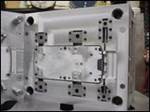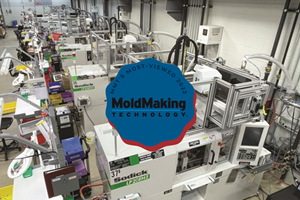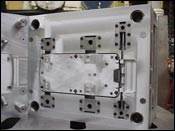Designing Molds That Work for You
Mold design approaches include full 2-D, a combination of 2-D and 3-D, and full 3-D.
Today's mold shop faces many challenges, with the number one challenge being delivery. Cost also is important, but for many time-to-market will outweigh the final cost that is paid for the mold.
As a mold shop gears up for its next project, a moldmaker needs to create or have created for him the road map to success - that map is the mold design. The person estimating the project will have ideas of what the mold should look like as well as most customers, but the poor moldmaker cannot have these people standing next to him for the weeks ahead guiding him through the mold's construction. That is where mold design comes into play - whether the layout is basic or fully detailed, the mold designer will create the road map for others to follow.
But what type of design should the designer give to the shop? Do they need a fully detailed design or just a layout? Will the shop want seamless CAD-to-CAM interface? What is the skill level of the toolmakers and of what is their equipment capable? This article will explore the strengths and weaknesses of 2-D and 3-D mold design through a focus on full 2-D design, a look at the combination of 2-D with 3-D and full 3-D mold design.
2-D Mold Design
Two-dimensional mold design is the computer-generated equivalent of a board drawing - otherwise known as stick drawings. The advantage of 2-D over board drawings is that the geometry should be correct, rather than just close - so if you need to scale any geometry accurately, you can check the design via access to a computer with CAD.
The 2-D design is quick to produce with the assistance of standard component templates, which is helpful with layouts being used for quoting. A downside to this is that the geometry is not parametric - you have to move the geometry to change the dimension. With parametric sketching (3-D drawings), the geometry is changed by changing the dimensions.
As with all mold designing, the designer should be filing all of the standard components that he will use in the design in an easy-to-find format - draw it once, use it often. The component manufacturer now provides many of these geometry files. For those custom-but-reusable items, the designer should draw only it once and then file it away for future use.
With this design layout, the designer is not concerned with placing items of the mold in all of the mold base plates - such as leader pins, bushings, screws, and so on. Once it is shown in the plan view and a section is cut, you are finished.
The 2-D design must be changed in all areas that a view is shown manually. For instance, if a part gets 1/8 of an inch longer, all of the views that relate to that increase should be changed manually.
When creating a native 2-D design, the design can be customized to look like a board drawing - section cuts can be adjusted if the section cut line does not go through the detail that needs to be shown. Basically, the 2-D design can produce a very pleasing and easy-to-follow picture of what the mold should look like when it is complete.
As a reminder, all geometry must be created and changed manually. This will be discussed more when considering the use of 3-D parametric geometry. But for now, if a line or item is moved or changed anywhere in the design, it must be changed everywhere else in the design that it appears; it will not automatically change or be updated.
2-D/3-D Mold Design
Two-dimensional/3-D mold design is probably the most popular way of designing a mold today - you can have control over the appearance of the flat 2-D design, the speed of the initial layout, and the precise geometry and functionality of the 3-D solid model.
Many customers today provide a 3-D solid model to the mold shop. This model can be imported into any of the software packages that are being used today. The mold designer imports the model, reviews it against the part drawing and checks the features that need to be addressed for molding (and moldmaking). Once the material shrinkage has been added, he is ready to use the geometry for the mold design.
When using this option for mold design, there are two approaches that can be used:
1. The designer takes the model, creates slices or cuts through it and then takes that geometry into the 2-D realm and completes the cavity/core layout for the design and detailing. This approach typically is used when the mold designer is using two different CAD packages for mold design and detailing. This way the designer does not have to use the product drawing to create the views that are needed - this is a large timesaver for the designer and the mold shop. The designer also could create the cavity/core assembly as a 3-D assembly, then create the section cuts and bring it into the 2-D drawing space.
2. Complete all of the cavity/core detailing work in 3-D. Then use the section cuts and place them into the 2-D mold design as mentioned above. The advantage is that the cavity/core detailing remains parametric. This is the most important part of the mold design, so it is best used this way. If different software is used, there could be a visual difference in the hard drawing copies, but in time this difference is easy to get used to when you consider the savings and advantages.
When using this approach, we need to remember that the 2-D mold design is not parametric to the 3-D detailing. So if a change is made to the cavity/core area, it will need to be changed manually in the 2-D drawing space. There are ways to make this more user-friendly through the 2-D CAD program for advanced users, but the geometry will need to be manually manipulated somewhere along the line.
Companies or designers will take this course because they usually use two different software packages for their 2-D and 3-D work. Many designers started off designing on the drafting board or using 2-D software, with which they became well versed in using; however, as the investment into 3-D increases, a new software package that is strong in solid modeling is typically used, which usually does not have a strong 2-D interface or the appearance that is desired by the designer or customer.
3-D Mold Design
3-D mold design is fully parametric; only time and the ability of the designer can limit what can be accomplished in this area.
When presenting a bid to design and build a mold for a new customer or existing customer, nothing is more pleasing than showing a past mold design in 3-D. The design can be rotated, shown in halves, up close, transparent, and so on.
Designing in full 3-D space is similar to building the individual components in the tool room. When done correctly, the design saves the moldmaker from having to create his sketches from scratch. The models of the components are ready for the CNC department.
Another advantage involves the customer's need to make a change to the product. The design will update to the new geometry once it replaces the old geometry; if details already have been created, they will update automatically.
A word of caution though, the designer always should verify that the design, details and drawings have updated correctly. Depending on how the mold was designed or placed together in the assembly, updating can go without a problem or minor fixes will be required.
When creating the 3-D mold design, the same rules that apply to 2-D design should be followed - model it once, use it many times. Today's component manufacturers are supplying many of their components as solid models. Should you need to model an item, save it to a component library for the future.
At first, the 3-D mold design will take a bit longer to get from the computer to the floor, but once it reaches the floor, the moldmaker and specialists can use the geometry of the solid model to make their jobs easier.
The models are then able to be sent to the floor before the mold designer has completed the design. As he creates the cavity/core assembly, he can verify sizes and interfacing locations to the mold base. Once this is complete, these items can be sent to the tool room for fabrication. The mold designer now can complete the mold base design and any components that will have to be manufactured by the tool room.
While the tool room is ordering steel and getting its game plan in order, the mold designer is preparing the assembly for the 2-D layout and detailing the necessary components for the shop.
There are those who look at full 3-D mold design as fluff, which means that not all of the components need to be in a solid model state - the mold base builder may not use the models that you supply, the moldmaker or machinist may not need a strap modeled, and so on. What is important is that it represents a clear view of the finished mold - errors are more easily seen in the fully assembled 3-D mold design.
Another drawback is the software. To keep the design fully parametric, it should be passed along the same software platform; otherwise, you can keep it as a 3-D solid model that is not parametric.
Individual designer skill level is another issue - as a designer becomes more familiar with the software and moves beyond the fundamentals, he may introduce skills into the mold design and detailing that the next person is not aware of or familiar with. This is an area that has to be addressed by the moldmaker or the customer because as we become faster, not everyone involved will be up to speed or have power user skill levels.
Conclusion
Moldmakers need to keep in mind that all shops are different in their approach to building a mold and possess different levels of talent. The end goal for everyone is to use the tools of the trade to stay on the cutting edge in a very competitive and challenging industry.
![]()
Related Content
Mold Builder Uses Counter-Intuitive Approach for Mold Challenges
Matrix Tool Inc. answers customers’ hard questions with creative solutions for cavity spacing, tool sizing, runner layout and melt delivery that reveal the benefits of running in a smaller press size at lower cavitation but higher yield.
Read MoreEditorial Guidelines: Editorial Advisory Board
The Editorial Advisory Board of MoldMaking Technology is made up of authorities with expertise within their respective business, industry, technology and profession. Their role is to advise on timely issues, trends, advances in the field, offer editorial thought and direction, review and comment on specific articles and generally act as a sounding board and a conscience for the publication.
Read MoreOEE Monitoring System Addresses Root Cause of Machine Downtime
Unique sensor and patent-pending algorithm of the Amper machine analytics system measures current draw to quickly and inexpensively inform manufacturers which machines are down and why.
Read MoreLeading Mold Manufacturers Share Best Practices for Improving Efficiency
Precise Tooling Solutions, X-Cell Tool and Mold, M&M Tool and Mold, Ameritech Die & Mold, and Cavalier Tool & Manufacturing, sit down for a fast-paced Q&A focused on strategies for improving efficiencies across their operations.
Read MoreRead Next
New Design Strategy for Generating Hybrid Aluminum Tooling
Design, machining and analysis software aids in aluminum mold manufacture.
Read MoreHow to Use Strategic Planning Tools, Data to Manage the Human Side of Business
Q&A with Marion Wells, MMT EAB member and founder of Human Asset Management.
Read MoreHow to Use Continuing Education to Remain Competitive in Moldmaking
Continued training helps moldmakers make tooling decisions and properly use the latest cutting tool to efficiently machine high-quality molds.
Read More





















